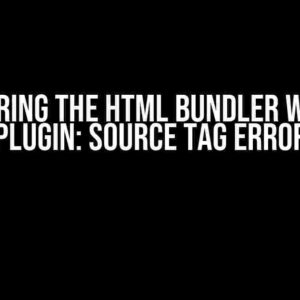Are you stuck on how to pass a Django form response through another template? Well, you’re in luck because this article is here to provide you with a comprehensive guide on how to do just that!
Django, being a high-level Python web framework, provides an efficient way to handle forms and their responses. However, when it comes to passing form responses through another template, things can get a bit tricky. But don’t worry, by the end of this article, you’ll be an expert in passing form responses like a pro!
Understanding Django Forms and Templates
Before we dive into the meat of the matter, let’s take a quick look at how Django forms and templates work.
Django Forms
In Django, forms are used to validate user input. They can be used to create, update, or delete data. A Django form is essentially a Python class that inherits from `django.forms.Form`. You can define fields, validation rules, and even custom validation methods using Python code.
Here’s an example of a simple Django form:
from django import forms
class ContactForm(forms.Form):
name = forms.CharField(max_length=100)
email = forms.EmailField()
message = forms.CharField(widget=forms.Textarea)
Django Templates
In Django, templates are used to render HTML pages. They’re essentially HTML files with placeholders for dynamic data. Django templates use a templating engine to replace placeholders with actual data.
Here’s an example of a simple Django template:
<h1>Contact Us</h1>
<p>Name: {{ name }}</p>
<p>Email: {{ email }}</p>
<p>Message: {{ message }}</p>
Passing Form Responses Through Another Template
Now that we’ve covered the basics of Django forms and templates, let’s get to the main event – passing form responses through another template!
Here’s the scenario: you have a form that submits to a view, and you want to display the form response on another template. Sounds simple, but how do you actually do it?
The key is to understand how to pass data from a view to a template. In Django, this is achieved using a concept called “template contexts”. A template context is essentially a dictionary that contains data to be rendered in a template.
Step 1: Create a View
The first step is to create a view that handles the form submission. In this view, you’ll validate the form and retrieve the form data.
from django.shortcuts import render
from .forms import ContactForm
def contact_view(request):
if request.method == 'POST':
form = ContactForm(request.POST)
if form.is_valid():
name = form.cleaned_data['name']
email = form.cleaned_data['email']
message = form.cleaned_data['message']
# Do something with the form data (e.g., save to database)
return render(request, 'response.html', {'name': name, 'email': email, 'message': message})
else:
form = ContactForm()
return render(request, 'contact.html', {'form': form})
In this example, we define a view called `contact_view` that handles both GET and POST requests. When the form is submitted, we validate the form data and retrieve the cleaned data using `form.cleaned_data`. We then pass this data to the `response.html` template using a dictionary.
Step 2: Create the Response Template
Next, we need to create a template to display the form response. Let’s call this template `response.html`.
<h1>Form Response</h1>
<p>Name: {{ name }}</p>
<p>Email: {{ email }}</p>
<p>Message: {{ message }}</p>
In this template, we use the template context variables `name`, `email`, and `message` to display the form response.
Step 3: Pass the Form Response to Another Template
Now, let’s say we want to pass the form response to another template called `summary.html`. We can do this by creating a new view that renders the `summary.html` template and passes the form response data as a template context.
def summary_view(request):
# Retrieve the form response data from the database (or wherever you stored it)
name = # retrieve name from database
email = # retrieve email from database
message = # retrieve message from database
return render(request, 'summary.html', {'name': name, 'email': email, 'message': message})
In this example, we define a new view called `summary_view` that retrieves the form response data from the database (or wherever you stored it). We then pass this data to the `summary.html` template using a dictionary.
Step 4: Display the Form Response in the Summary Template
Finally, we need to display the form response in the `summary.html` template. We can do this using template tags and filters.
<h1>Form Summary</h1>
<ul>
<li>Name: {{ name }}</li>
<li>Email: {{ email }}</li>
<li>Message: {{ message }}</li>
</ul>
In this template, we use an unordered list to display the form response data. We use template variables `name`, `email`, and `message` to display the data.
Conclusion
And that’s it! You’ve successfully passed a Django form response through another template. By following these steps, you can create complex workflows that involve multiple templates and forms.
Remember to keep your views and templates organized, and don’t be afraid to use Django’s built-in features to simplify your code.
| Tips and Tricks |
|---|
| ‘Use Django’s built-in form validation to simplify your code.’. |
| ‘Use template inheritance to avoid duplicated code.’。 |
| ‘Use Django’s built-in templating engine to render templates.’。 |
Frequently Asked Questions
Q: How do I pass data from a view to a template?
A: You can pass data from a view to a template using a dictionary. In the view, return the `render` shortcut with the template name and the data as a dictionary.
Q: How do I retrieve form data in a view?
A: You can retrieve form data in a view using `request.POST` or `request.GET`. You can then validate the form data using `form.is_valid()` and retrieve the cleaned data using `form.cleaned_data`.
Q: Can I use Django’s built-in form validation?
A: Yes! Django provides a built-in form validation system. You can define validation rules and custom validation methods using Python code.
I hope this article has helped you understand how to pass a Django form response through another template. If you have any questions or need further clarification, feel free to ask!
Further Reading
Happy coding!
Here are 5 Questions and Answers about “How to pass a Django form response through another template”:
Frequently Asked Question
Get the lowdown on how to pass a Django form response through another template with these expert answers!
What is the main challenge in passing a Django form response through another template?
One of the biggest hurdles in passing a Django form response through another template is ensuring that the template context is properly populated with the form data. This requires a deep understanding of Django’s template language and the nuances of form handling in Django.
How do I access the form data in a separate template?
To access the form data in a separate template, you can use the `request` object to pass the form instance to the template. In your view, you can do this by adding the form instance to the template context, like so: `return render(request, ‘template.html’, {‘form’: form})`. Then, in your template, you can access the form data using `{{ form }}`.
Can I use a separate view to handle the form response?
Yes, you can use a separate view to handle the form response. In fact, this is a common approach in Django. By creating a separate view for the form response, you can keep your code organized and reusable. Simply create a new view function that handles the form response and returns the render response to the template.
How do I preserve the form data when redirecting to another template?
To preserve the form data when redirecting to another template, you can use Django’s built-in `messages` framework to store the form data in the session. This way, the form data will be preserved across requests. Simply use the `messages.add_message` function to store the form data in the session, and then retrieve it in your next view using `messages.get_messages`.
What are some best practices for passing form responses through multiple templates?
Some best practices for passing form responses through multiple templates include keeping your templates simple and focused on a single task, using template inheritance to avoid duplicated code, and leveraging Django’s built-in form handling features to simplify your code. Additionally, be mindful of security best practices, such as validating user input and protecting against CSRF attacks.






